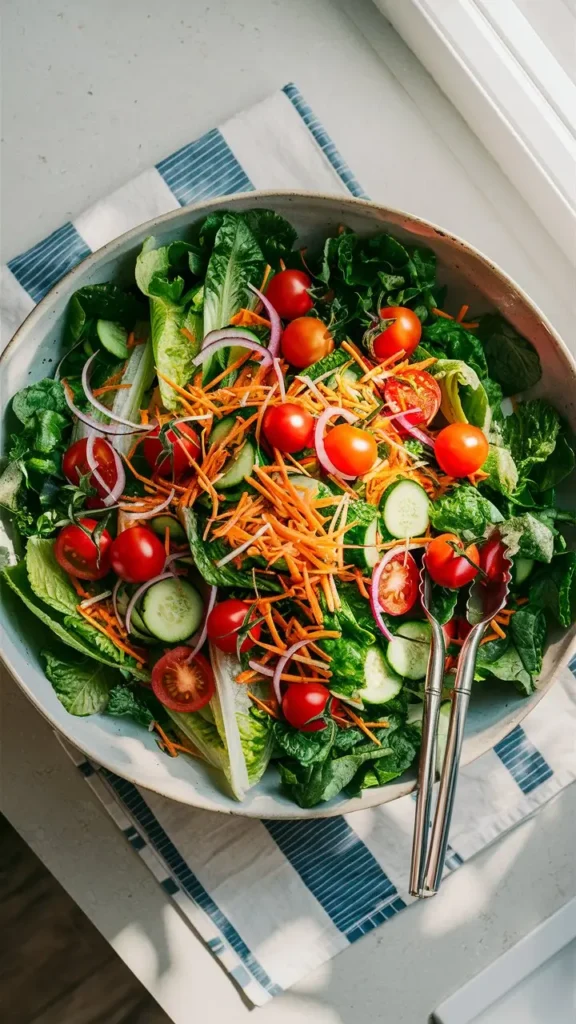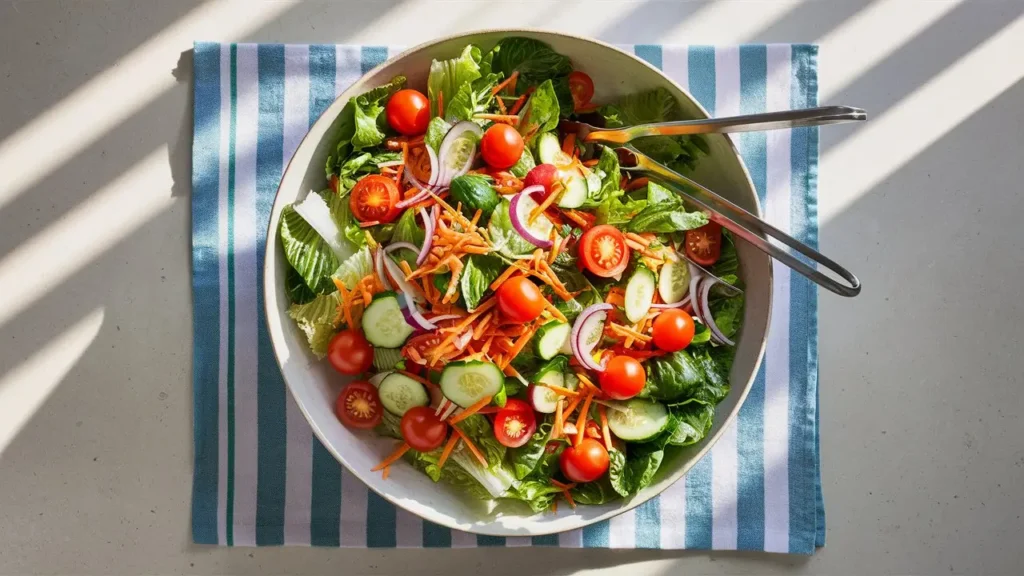A fresh garden salad recipe is one of the simplest and healthiest dishes you can prepare, yet it offers endless variety and flavor combinations. Whether you enjoy it as a starter, side dish, or a light main course, garden salad celebrates crisp vegetables, vibrant colors, and refreshing textures. This article covers everything you need to know to create the perfect garden salad—from ingredients and dressings to tips, variations, and more.

Why You Will Love This Recipe
-
Quick and Easy – You can throw it together in under 15 minutes with minimal prep.
-
Healthy and Nutritious – Loaded with fiber, vitamins, and antioxidants.
-
Customizable – Swap in your favorite veggies, proteins, and dressings.
-
Perfect for Any Meal – Serve it for lunch, dinner, or even at parties and gatherings.
Ingredients List
Here’s a basic list of ingredients for a classic garden salad. You can modify based on what you have on hand or your preferences.
Base Vegetables:
-
4 cups mixed greens (romaine, iceberg, leaf lettuce, arugula, or spinach)
-
1 cup cherry tomatoes, halved
-
1 cucumber, thinly sliced
-
1 carrot, shredded or julienned
-
½ red onion, thinly sliced
-
½ cup red or green bell pepper, thinly sliced
Optional Add-Ins:
-
¼ cup sliced radishes
-
¼ cup corn kernels (fresh, canned, or grilled)
-
¼ cup shredded purple cabbage
-
¼ cup olives (black or green)
Dressing:
-
3 tablespoons olive oil
-
1 tablespoon red wine vinegar or lemon juice
-
1 teaspoon Dijon mustard
-
1 garlic clove, minced
-
Salt and pepper to taste
Timing & Servings
-
Prep Time: 15 minutes
-
Cook Time: 0 minutes
-
Total Time: 15 minutes
-
Servings: 4
Step-by-Step Instructions for Garden Salad Recipe
Step 1: Wash and Dry the Vegetables
Thoroughly rinse all vegetables under cold water. Use a salad spinner or pat with paper towels to ensure they are completely dry—this helps dressing stick better.
Step 2: Chop and Prepare the Ingredients
Slice cucumbers, onions, peppers, and other vegetables as needed. Tear the greens into bite-sized pieces. For added texture, keep some of the veggies chunky.
Step 3: Make the Dressing
In a small bowl or mason jar, whisk together olive oil, vinegar (or lemon juice), mustard, garlic, salt, and pepper until well blended.
Step 4: Assemble the Salad
In a large mixing bowl, toss the greens and vegetables. Drizzle the dressing over the salad just before serving and toss again to coat evenly.
Step 5: Serve Immediately
Serve the garden salad fresh to maintain the crispness of the vegetables.

Tips for the Best Garden Salad
Use Seasonal Produce
Fresh, in-season vegetables taste better and add variety throughout the year.
Add a Crunch Element
Croutons, toasted nuts, or seeds like sunflower or pumpkin seeds provide texture and interest.
Balance Flavors
Include sweet (like carrots), salty (like olives), and tangy (like tomatoes or vinaigrette) elements for a well-rounded taste.
Avoid Soggy Salad
Only dress the amount of salad you’ll eat immediately. Keep the rest undressed for storage.
Garden Salad Dressing Ideas
A dressing can make or break a salad. Here are some flavorful options:
Classic Vinaigrette
-
3:1 olive oil to vinegar, plus herbs like oregano or thyme.
Creamy Ranch
-
Mix mayonnaise, sour cream, herbs, garlic, and lemon juice.
Lemon Herb
-
Lemon juice, olive oil, parsley, garlic, and black pepper.
Balsamic Vinaigrette
-
Balsamic vinegar, honey, mustard, and olive oil for a sweet-tangy taste.
Garden Salad Variations
Garden Salad with Protein
Add grilled chicken, tuna, chickpeas, hard-boiled eggs, or tofu to turn your garden salad into a satisfying main course.
Garden Pasta Salad
Mix cooked pasta like rotini or penne with garden salad ingredients for a filling twist. Add feta or mozzarella balls.
Fruit & Nut Garden Salad
Include apple slices, dried cranberries, or orange segments with walnuts or almonds for sweetness and crunch.
Garden Greek Salad
Add feta cheese, olives, oregano, and cucumber-heavy ingredients for a Mediterranean version.
Make-Ahead Tips
Store Ingredients Separately
Keep veggies, proteins, and dressings in separate containers to avoid wilting.
Dry Greens Completely
Excess moisture leads to sogginess. A salad spinner is your best friend for crisp greens.
Pre-Chop Veggies
Chop onions, cucumbers, and peppers in advance. Store in airtight containers in the fridge for up to 3 days.
Serving Suggestions
Garden salad is incredibly versatile and pairs well with many dishes:
-
As a starter before pasta or grilled meals
-
With soup and crusty bread for a light lunch
-
As a side for sandwiches, burgers, or wraps
-
Topped with grilled meat or seafood for a complete entrée
Nutritional Overview (Per Serving, Approximate)
-
Calories: 160
-
Fat: 10g
-
Carbs: 14g
-
Protein: 3g
-
Fiber: 4g
-
Vitamin A: 120% RDA
-
Vitamin C: 60% RDA
-
Calcium: 6% RDA
-
Iron: 8% RDA
Note: Nutritional values will vary based on ingredients and portion sizes.
Storing Leftovers
How to Store
-
Store undressed salad in an airtight container in the refrigerator for up to 2–3 days.
-
Keep dressing in a separate container for longer shelf life.
Reviving Leftovers
If the greens start to wilt, add a few fresh leaves and toss with a fresh drizzle of dressing before serving.
Garden Salad for Special Occasions
Garden salad is perfect for potlucks, holiday meals, and parties. To make it special:
-
Serve in a wooden bowl or large platter
-
Garnish with edible flowers or fresh herbs
-
Add unique toppings like marinated artichokes or goat cheese
FAQs
Can I make this salad vegan?
Yes. This salad is naturally vegan as long as the dressing doesn’t include dairy or honey.
Can I use bottled dressing?
Yes, but homemade dressing tastes fresher and allows full control over ingredients.
Can I use spinach or arugula instead of lettuce?
Absolutely! Spinach, arugula, kale, or even mixed spring greens all work well.
How can I make the salad more filling?
Add protein (like grilled chicken or tofu), beans, nuts, seeds, or whole grains like quinoa.
Conclusion
Garden salad is more than just a side dish—it’s a vibrant celebration of fresh ingredients and bold flavors. Whether you’re tossing it together for a quick lunch or crafting an elegant starter for dinner guests, this recipe delivers. Its flexibility, health benefits, and ease make it a staple for any home cook.
Make it your own with seasonal vegetables, dressings, and toppings. With this guide in hand, you’re well-equipped to build a garden salad that’s as beautiful as it is delicious.
